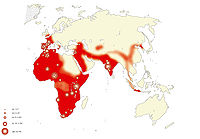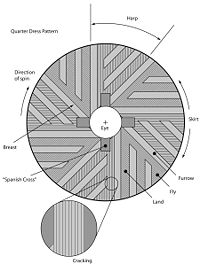-
Use Cases
-
Resources
-
Pricing
Transition to Neolithic
Neolithic cultures emerge in fertile crescent
7000 BC
% complete
The first Neolithic cultures emerged around 7000 BC in the fertile crescent, marking a significant shift towards agriculture and settled communities.
Image source: Neolithic

Transition out of the Stone Age in North Africa and Eurasia
6000 BC - 2500 BC
% complete
The transition out of the Stone Age occurred between 6000 and 2500 BC for much of humanity living in North Africa and Eurasia.
Middle East and Southeast Asia progress past Stone Age technology
6000 BC
% complete
The Middle East and Southeast Asian regions progressed past Stone Age technology around 6000 BC, adopting new advancements and technologies.
Europe and rest of Asia become post-Stone Age societies
4000 BC
% complete
Europe and the rest of Asia transitioned into post-Stone Age societies by about 4000 BC, embracing new cultural and technological developments.
Image source: Stone Age

Ġgantija temples built in the Maltese archipelago
3600 BC - 2500 BC
% complete
The Ġgantija temples in the Maltese archipelago are the oldest surviving free-standing structures in the world, constructed between approximately 3600 and 2500 BC.
Image source: Ġgantija

Ötzi the Iceman carries copper axe and flint knife
3300 BC
% complete
Ötzi the Iceman, a mummy from around 3300 BC, was discovered with a copper axe and a flint knife, providing evidence of early metalworking during the transition to the Neolithic period.
Image source: Ötzi

Proto-Inca cultures enter Metal Age in South America
2000 BC
% complete
The proto-Inca cultures in South America reached the Metal Age around 2000 BC, with the introduction of gold, copper, and silver.
Image source: Metallurgy

Stone Age Cultures
Three-age system adapted by archaeologists
1800 - 1999
% complete
Archaeologists in the late 19th and early 20th centuries adapted the three-age system to categorize Stone Age cultures and understand the progression of human civilization.
Image source: Three-age system

Three-age system not applicable in Africa
1800 - 1899
% complete
The three-age system, originally developed for Europe, was found to have no validity in Africa outside the Nile valley.
Three-stage system proposed for South Africa
1929
% complete
In 1929, the three-stage system was proposed by Astley John Hilary Goodwin and Clarence van Riet Lowe for understanding Stone Age cultures in South Africa.
First Pan African Congress adopts Three-Stage Chronology
1947
% complete
The First Pan African Congress in 1947 adopted the Three-Stage Chronology for studying Stone Age cultures, aiming to understand the progression of human development in Africa.
Image source: Pan-African Congress

Intermediates rejected in African archaeology
1965
% complete
In 1965, the intermediates in the Three-Stage Chronology were officially rejected by the Burg Wartenstein Conference, a significant conference in anthropology attended by prominent scholars.
Film "Quest for Fire" depicts early Homo sapiens
1981
% complete
The 1981 film "Quest for Fire" directed by Jean-Jacques Annaud tells the story of early Homo sapiens searching for fire, showcasing the struggles and triumphs of our Stone Age ancestors.
Image source: The Quest for Fire

Book series "Chronicles of Ancient Darkness" set in New Stone Age
2000 - 2099
% complete
The book series "Chronicles of Ancient Darkness" by Michelle Paver is set in the New Stone Age, following two children as they navigate a prophecy and seek to save their clan.
Image source: Chronicles of Ancient Darkness

Stone Age depicted in documentary series "Walking with Cavemen"
2003
% complete
The 2003 documentary series "Walking with Cavemen" portrayed the evolution of humans through the Stone Age, providing insights into the lives of our early ancestors.
Image source: Walking with Cavemen

Early Stone Age
Transition between Hominans and cultures questioned
1800 - 1999
% complete
In the late 19th and early 20th centuries, archaeologists began questioning the succession of Hominans and cultures, seeking to understand the transitions between them.
Jens Jacob Worsaae proposes division of Stone Age
1859
% complete
In 1859, Jens Jacob Worsaae proposed a division of the Stone Age into older and younger parts based on his work with Danish kitchen middens.
Paleolithic period recognized as earliest division of Stone Age
1865
% complete
The Paleolithic period, coined by John Lubbock in 1865, became recognized as the earliest division of the Stone Age.
Image source: Paleolithic

Term "Pre-Acheulean" used in climatology
1900 - 1999
% complete
In the early 20th century, the term "Pre-Acheulean" came into use in climatology, referring to a period before the Acheulean stone tool industry.
Image source: Acheulean

Stone Age Technology
Millstones in use in Europe and North America
1900 - 1999
% complete
Millstones continued to be used in Europe and North America until well into the 20th century, and are still used in many parts of the world today.
Image source: Millstone

Key Facts
- The Paleolithic period was characterized by the use of stone tools and the development of early human culture.
- During the Mesolithic period, humans began to domesticate plants and animals, leading to a more settled way of life.
- The Neolithic period marked the transition from hunting and gathering to agriculture and the rise of early civilizations.
- The invention of pottery during the Stone Ages revolutionized food storage and cooking techniques.
- Artistic expression also emerged during the Stone Ages, with cave paintings being a significant example.
Source
This Stone Age timeline was generated with the help of AI using information found on the internet.
We strive to make these timelines as accurate as possible, but occasionally inaccurates slip in. If you notice anything amiss, let us know at [email protected] and we'll correct it for future visitors.
Create a timeline like this one for free
Preceden lets you create stunning timelines using AI or manually.
Customize your timeline with one of our low-cost paid plans
Export your timeline, add your own events, edit or remove AI-generated events, and much more
Free
$
0
free forever
No credit card required.
Basic
$
10
/month
billed annually
Cancel anytime.
Pro
$
16
/month
billed annually
Cancel anytime.
Common Questions
Can I cancel anytime?
Yes. You can cancel your subscription from your account page at anytime which will ensure you are not charged again. If you cancel you can still access your subscription for the full time period you paid for.
Will you send an annual renewal reminder?
Yes, we will email you a reminder prior to the annual renewal and will also email you a receipt.
Do you offer refunds?
Yes. You can email us within 15 days of any payment and we will issue you a full refund.
What if I have more questions?
Check out our pricing docs or send us an email anytime: [email protected].